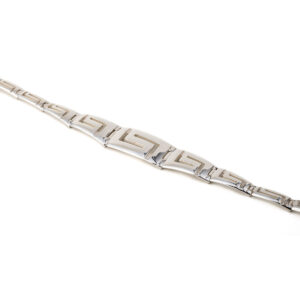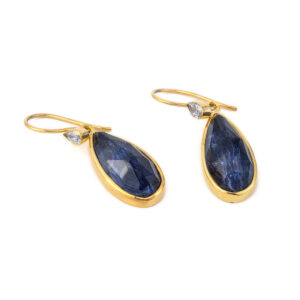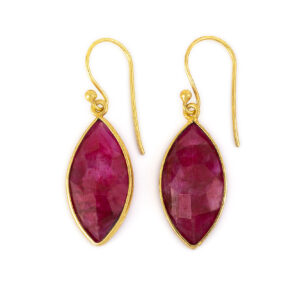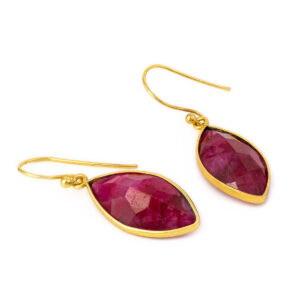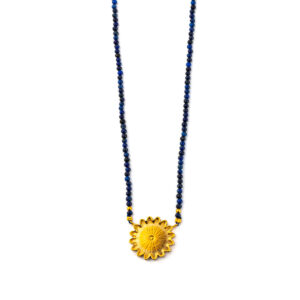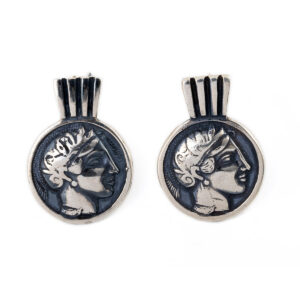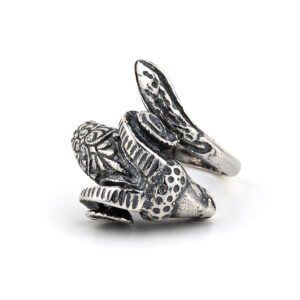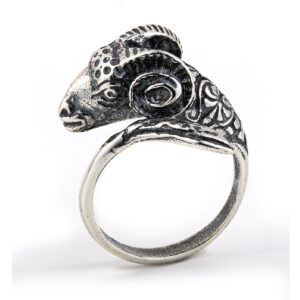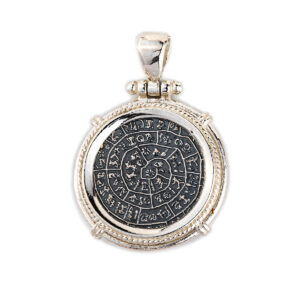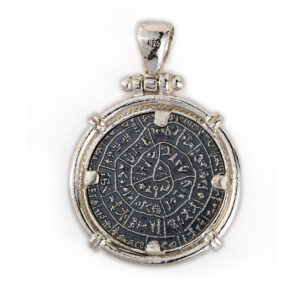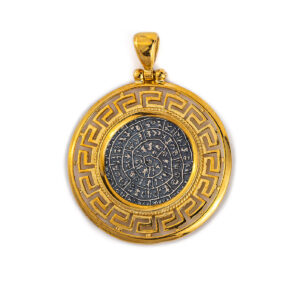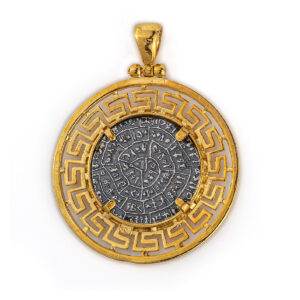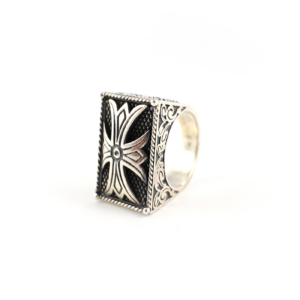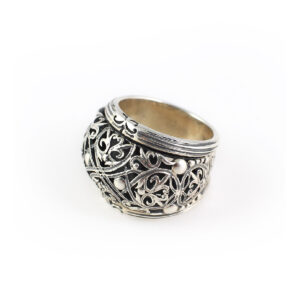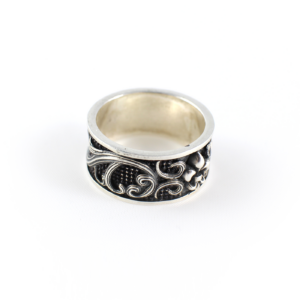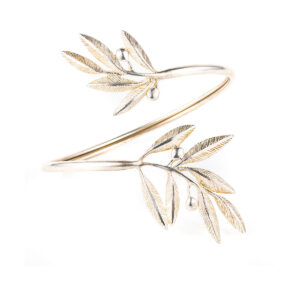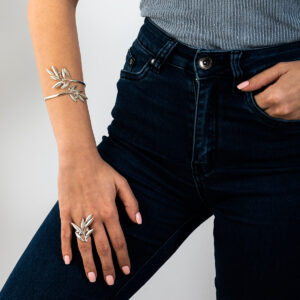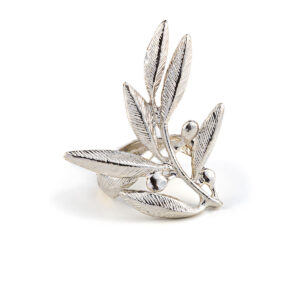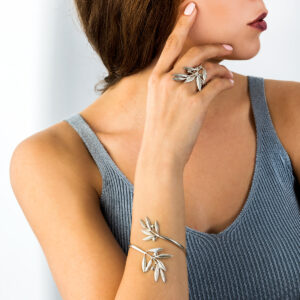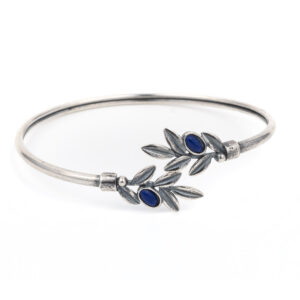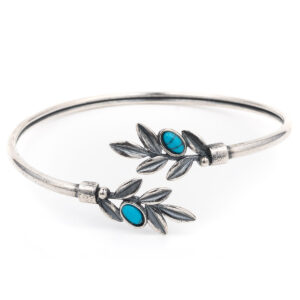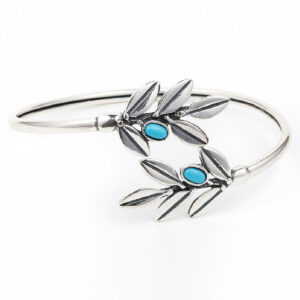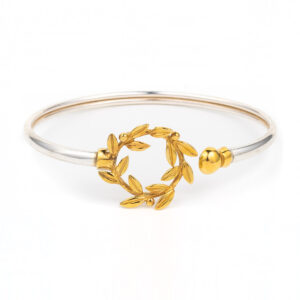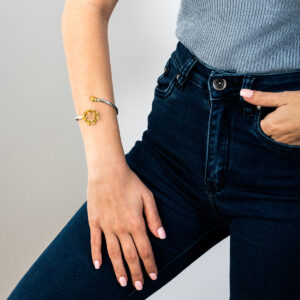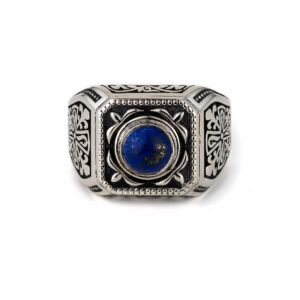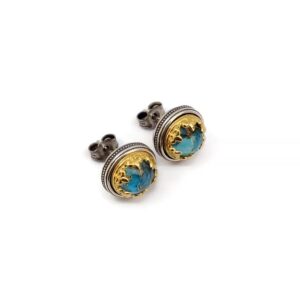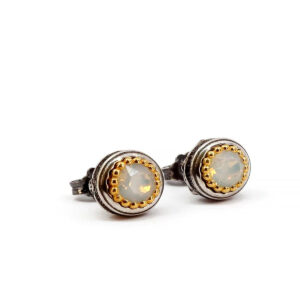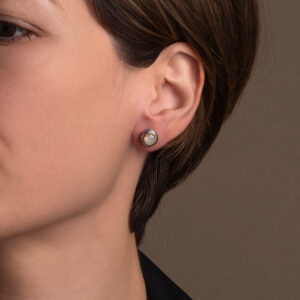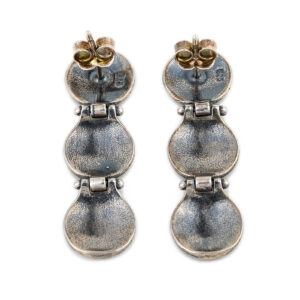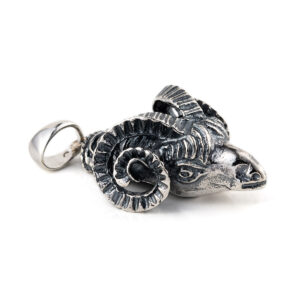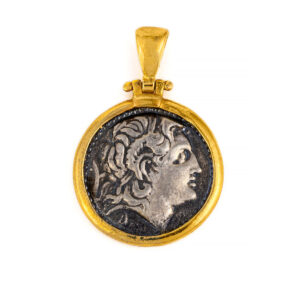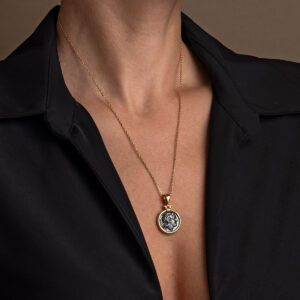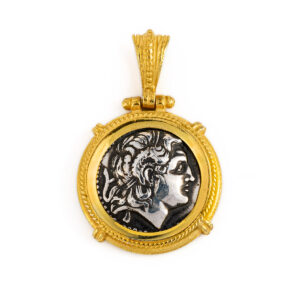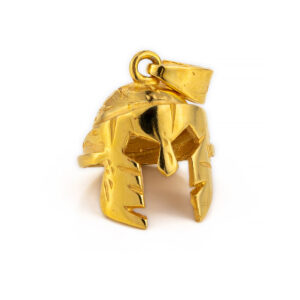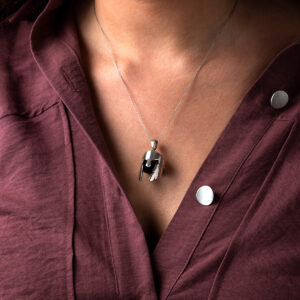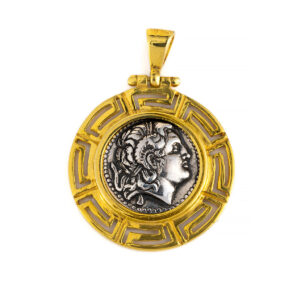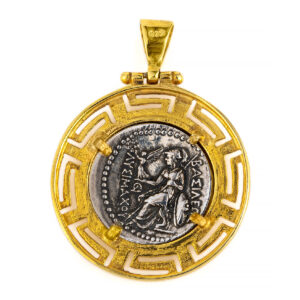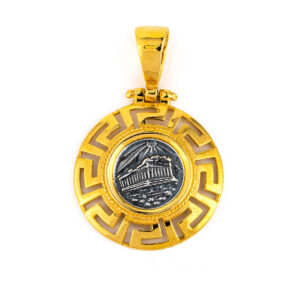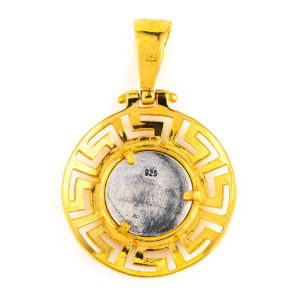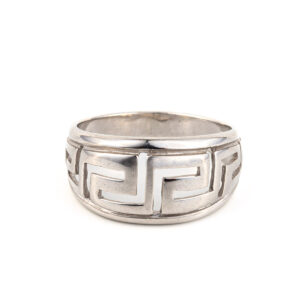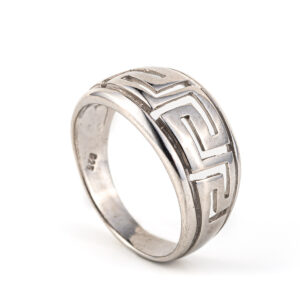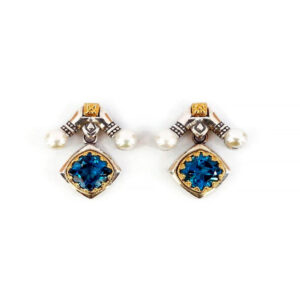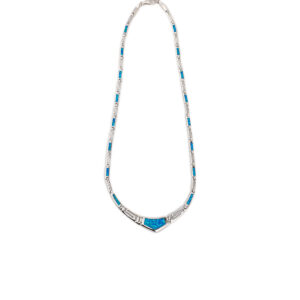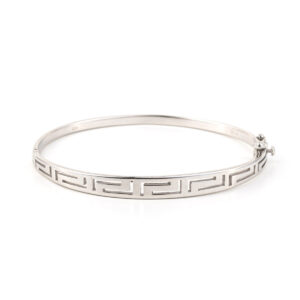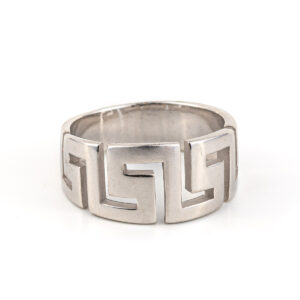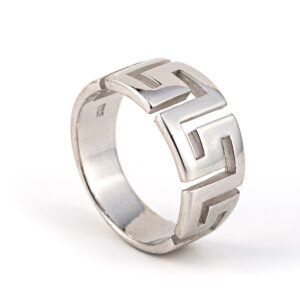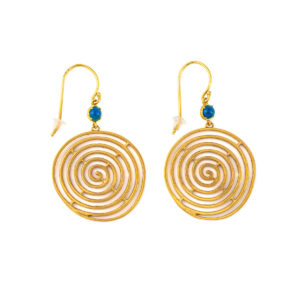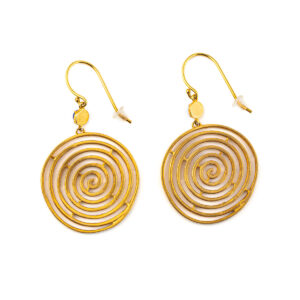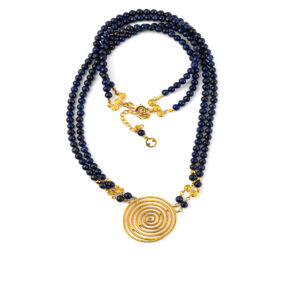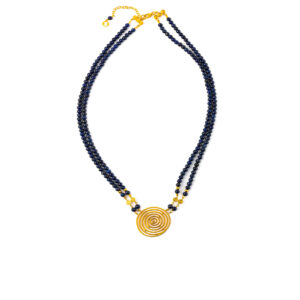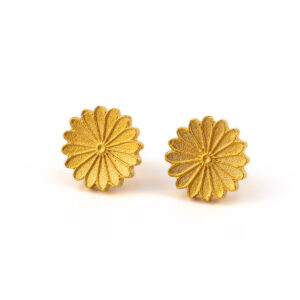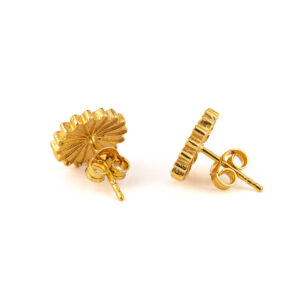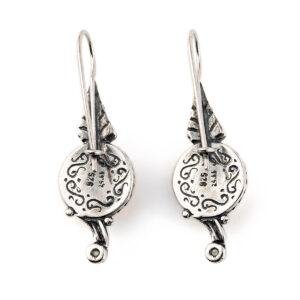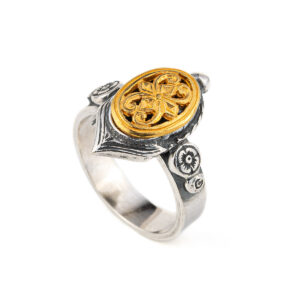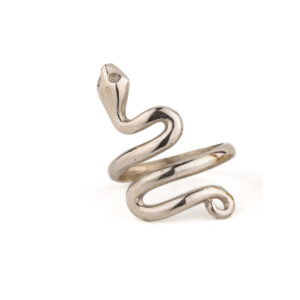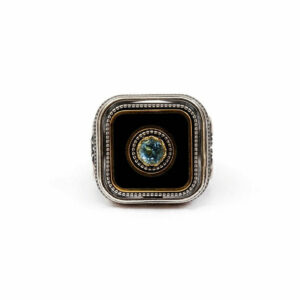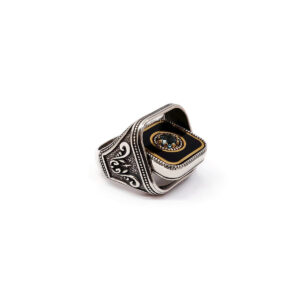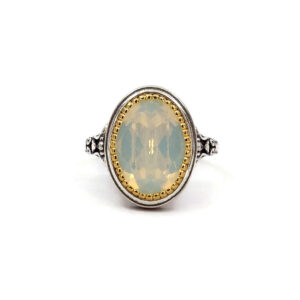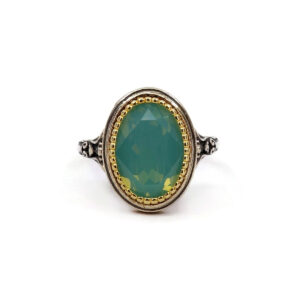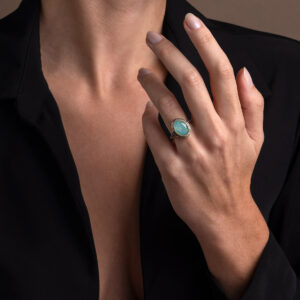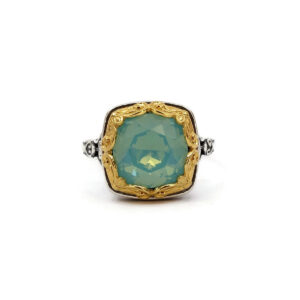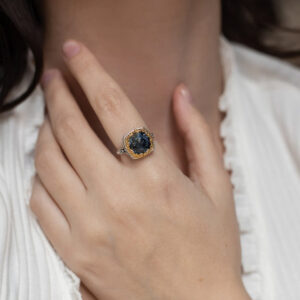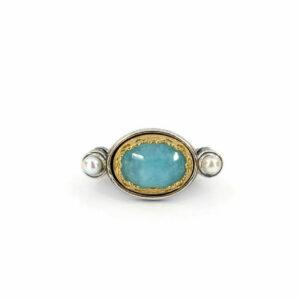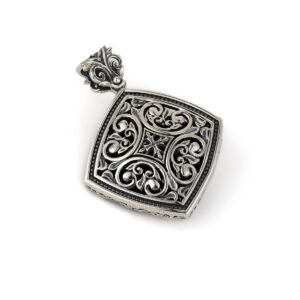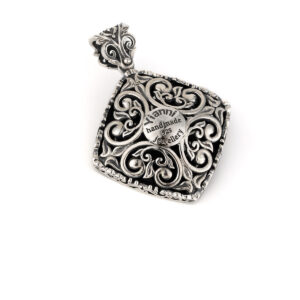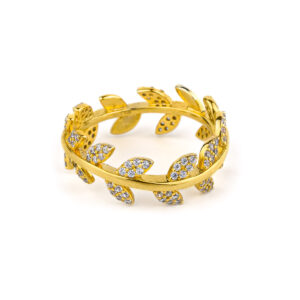Βραχιόλι Μαίανδρος από Ασήμι 925
Κατασκευασμένο από Ασήμι 925.
Χειροποίητο Ελληνικό κόσμημα.
Σκουλαρίκια με Σοδαλίτη – Ασήμι 925 και Επιχρυσωμένα
Κατασκευασμένα από Ασήμι 925 και επιχρυσωμένα.
Χειροποίητο Ελληνικό κόσμημα.
Σκουλαρίκια με Ρουμπινίτη – Ασήμι 925 και Επιχρυσωμένα
Κατασκευασμένα από Ασήμι 925 και επιχρυσωμένα.
Χειροποίητο Ελληνικό κόσμημα.
Κολιέ Λουλούδι με Χάντρες – Ασήμι 925 και Επιχρυσωμένο
Κατασκευασμένο από Ασήμι 925.
Χειροποίητο Ελληνικό κόσμημα.
Σκουλαρίκια με Θεά Αθηνά – Ασήμι 925
Από ασήμι 925°.
Χειροποίητο ελληνικό κόσμημα.
Ανακαλύψτε τη Συλλογή Νομίσματα
Η θεά Αθηνά συνδέεται με τη σοφία, τη χειροτεχνία και τον πόλεμο. Η Αθηνά θεωρούνταν προστάτιδα και φύλακας διαφόρων πόλεων σε όλη την Ελλάδα, ιδίως της πόλης της Αθήνας, από την οποία πιθανότατα έλαβε και το όνομά της. Συνήθως απεικονίζεται στην τέχνη φορώντας κράνος και κρατώντας δόρυ. Τα κυριότερα σύμβολά της περιλαμβάνουν κουκουβάγιες, ελαιόδεντρα και φίδια. Οι ναοί της βρίσκονταν στην κορυφή της οχυρωμένης Ακρόπολης στο κεντρικό τμήμα της πόλης. Ο Παρθενώνας στην αθηναϊκή Ακρόπολη είναι αφιερωμένος σε αυτήν, μαζί με πολλούς άλλους ναούς και μνημεία. Η κύρια γιορτή της στην Αθήνα ήταν τα Παναθήναια, τα οποία γιορτάζονταν στα μέσα του καλοκαιριού και ήταν η σημαντικότερη γιορτή στο αθηναϊκό ημερολόγιο.
Δαχτυλίδι με Κριάρι από Ασήμι 925
Στην αρχαία ελληνική μυθολογία, το κριάρι ήταν σύμβολο αρρενωπότητας και γονιμότητας, δύναμης και ηγεσίας. Το κεφάλι του κριαριού συμβολίζει επίσης τον Κριό, το πρώτο ζώδιο του ζωδιακού κύκλου.
Κατασκευάζεται από ασήμι 925⁰.
Χειροποίητο ελληνικό κόσμημα.
Μενταγιόν Δίσκος της Φαιστού – Ασήμι 925
Μενταγιόν Δίσκος της Φαιστού – Ασήμι 925 και Επιχρυσωμένο
Δαχτυλίδι Βυζαντινό από Ασήμι 925 – Yianni Jewelry
Κατασκευασμένο από ασήμι 925.
Χειροποίητο ελληνικό κόσμημα.
Αυτές οι ασημένιες δημιουργίες των κοσμημάτων Yianni, δημιουργήθηκαν από τον Garbis Khacherian, έμπορο αργυροχοΐας από το 1987.
Ανακαλύψτε τη συλλογή Yianni
Δαχτυλίδι Βυζαντινό από Ασήμι 925 – Yianni Jewelry
Κατασκευασμένο από ασήμι 925.
Χειροποίητο ελληνικό κόσμημα.
Αυτές οι ασημένιες δημιουργίες των κοσμημάτων Yianni, δημιουργήθηκαν από τον Garbis Khacherian, έμπορο αργυροχοΐας από το 1987.
Ανακαλύψτε τη συλλογή Yianni
Δαχτυλίδι Βυζαντινό από Ασήμι 925 – Yianni Jewelry
Κατασκευασμένο από ασήμι 925.
Χειροποίητο ελληνικό κόσμημα.
Αυτές οι ασημένιες δημιουργίες των κοσμημάτων Yianni, δημιουργήθηκαν από τον Garbis Khacherian, έμπορο αργυροχοΐας από το 1987.
Ανακαλύψτε τη συλλογή Yianni
Δαχτυλίδι Βυζαντινό από Ασήμι 925 – Yianni Jewelry
Κατασκευασμένο από ασήμι 925.
Χειροποίητο ελληνικό κόσμημα.
Αυτές οι ασημένιες δημιουργίες των κοσμημάτων Yianni, δημιουργήθηκαν από τον Garbis Khacherian, έμπορο αργυροχοΐας από το 1987.
Ανακαλύψτε τη συλλογή Yianni
Olive Leaf Hinge Bracelet – 925 Sterling Silver
The olive wreath also known as kotinos was the prize for the winner at the ancient Olympic Games. It was an olive branch, of the wild- olive tree that grew at Olympia,intertwined to form a circle or a horse-shoe. According to Pausanias it was introduced by Heracles as a prize for the running race winner to honour his father Zeus. In the ancient Olympic Games there were no gold, silver, or bronze medals. There was only one winner per event, crowned with an olive wreath made of wild-olive leaves from a sacred tree near the temple of Zeus at Olympia. Olive wreaths were given out during the 2004 Summer Olympics in Athens in honor of the ancient tradition, because the games were being held in Greece.
Available in gold and silver.
Made in 925⁰ sterling silver
This beautiful bracelet is bendable and is slid on to the wrist.
Handmade item.
Ancient Greek Ring with olive leaves – Sterling Silver
Ancient Greek ring with olive leaves.
The olive tree in Ancient Greece was a symbol of the Olympic ideal, since an olive branch was the only prize for the Olympic champions. Τhe olive tree symbolizes peace, victory, honor and prosperity.
Αlso available in gold-plated.
Made of 925⁰ sterling silver
Handmade item
Olive Leaves Bracelet With Stones
This is a elegant and unique silver bracelet with olive leaves and stones.The olive wreath also known as kotinos was the prize for the winner at the ancient Olympic Games. It was an olive branch, of the wild- olive tree that grew at Olympia,intertwined to form a circle or a horse-shoe. According to Pausanias it was introduced by Heracles as a prize for the running race winner to honour his father Zeus. In the ancient Olympic Games there were no gold, silver, or bronze medals. There was only one winner per event, crowned with an olive wreath made of wild-olive leaves from a sacred tree near the temple of Zeus at Olympia. Olive wreaths were given out during the 2004 Summer Olympics in Athens in honor of the ancient tradition, because the games were being held in Greece.
The bracelet is bendable.
Handmade item.
Olive Leaves Silver Bracelet
Olive Leaves Silver Bracelet. A beautiful and elegant bracelet tribute to the olive branch, a symbol of peace, abundance and achievement. The olive wreath also known as kotinos was the prize for the winner at the ancient Olympic Games. It was an olive branch, of the wild- olive tree that grew at Olympia,intertwined to form a circle or a horse-shoe. According to Pausanias it was introduced by Heracles as a prize for the running race winner to honour his father Zeus. In the ancient Olympic Games there were no gold, silver, or bronze medals. There was only one winner per event, crowned with an olive wreath made of wild-olive leaves from a sacred tree near the temple of Zeus at Olympia. Olive wreaths were given out during the 2004 Summer Olympics in Athens in honor of the ancient tradition, because the games were being held in Greece.
The bracelet is bendable.
Handmade item.
Gold Plated Olive Wreath Bracelet
Gold Plated Olive Wreath Bracelet inspired from ancient Greek kotinos design.
The olive wreath also known as kotinos was the prize for the winner at the ancient Olympic Games. It was an olive branch, of the wild- olive tree that grew at Olympia,intertwined to form a circle or a horse-shoe. According to Pausanias it was introduced by Heracles as a prize for the running race winner to honour his father Zeus. In the ancient Olympic Games there were no gold, silver, or bronze medals. There was only one winner per event, crowned with an olive wreath made of wild-olive leaves from a sacred tree near the temple of Zeus at Olympia. Olive wreaths were given out during the 2004 Summer Olympics in Athens in honor of the ancient tradition, because the games were being held in Greece.
The bracelet is bendable.
Handmade item.
Δαχτυλίδι με Λάπις Yianni – Ασήμι 925
Κατασκευασμένο από ασήμι 925.
Χειροποίητο ελληνικό κόσμημα.
Αυτές οι ασημένιες δημιουργίες των κοσμημάτων Yianni, δημιουργήθηκαν από τον Garbis Khacherian, έμπορο αργυροχοΐας από το 1987.
Ανακαλύψτε τη συλλογή Yianni
Byzantine Stud Earrings with Doublet Turquoise Copper – Sterling Silver 925 Gold Plated
Byzantine stud earrings with doublet turquoise copper 8mm round gemstone.
Sterling Silver 925 With gold plated part.
Byzantine Stud Earrings with White Opal Swarovski – Sterling Silver 925 Gold Plated
Byzantine stud earrings with swarovski white opal 6mm round stone.
Sterling Silver 925 With gold plated part.
Phaistos Disk Drop Earrings
This beautiful pair of earrings representing the disc of Phaistos. The Phaistos Disc is a disk of fired clay from the Minoan palace of Phaistos on the island of Crete. Now, the island of Crete is part of modern Greece. The disc was discovered in 1908 by the Italian archaeologist Luigi Pernier in the Minoan palace-site of Phaistos. While it is not clear that it is a script, most attempted decipherments assume that it is; most additionally assume a syllabary, others an alphabet or logography or a calendar, making it one of the most famous mysteries of archaeology. The disk is about 15 cm in diameter and covered on both sides with a spiral of stamped symbols. The disc features 241 tokens, comprising 45 distinct signs, which were apparently made by pressing hieroglyphic “seals” into a disc of soft clay, in a clockwise sequence spiraling toward the center of the disk. This unique object is now on display at the archaeological museum of Heraklion.
Made in 925⁰ sterling silver.
Handmade item.
Ram Head Pendant
Ram’s head pendant in sterling silver.
In Greek mythology, the Golden Fleece (Greek: χρυσόμαλλον δέρας) is the fleece of the golden-woolled,winged ram, which was held in Colchis. The fleece is a symbol of authority and kingship. It figures in the tale of the hero Jason and his crew of Argonauts, who set out on a quest for the fleece by order of King Pelias, in order to place Jason rightfully on the throne of Iolcus in Thessaly. Through the help of Medea, they acquire the Golden Fleece. The story is of great antiquity and was current in the time of Homer (eighth century BC). The ram was symbol of virility and fertility, power and leadership.
Handmade item.
Hercules Coin Pendant – 925 Sterling Silver and Gold Plated
Handmade item.
Made in 925°sterling silver and gold plated.
Hercules – Tetradracm
The head of Heracles, wearing a lion’s hide and perhaps bearing the features of Alexander, is engraved on the obverse. Enthroned Zeus, holding an eagle is depicted on the reverse. The inscription of Alexander is also engraved on the reverse. Hercules is a Roman hero and god, the most popular figure from ancient Greek mythology. He was the equivalent of the Greek divine hero Heracles, who was the son of Zeus and the mortal woman Alcmene. In classical mythology, Hercules is famous for his strength and for his numerous far-ranging adventures.
Alexander the Great Pendant – Sterling Silver and Gold Plated
Ancient Greek coin represent Alexander the great one one side and king Lysimachus on the other. Alexander the Great the King of Macedonia is considered one of the most important forms of world history. Lysimachus was a Macedonian officer and diadochus of Alexander the Great, who became a basileus in 306 BC, ruling Thrace, Asia Minor and Macedon.
Made of 925⁰ sterling silver and gold plated.
Handmade item.
Μενταγιόν με Μέγα Αλέξανδρο – Ασήμι 925 και Επιχρυσωμένο
Εμπνευσμένο από το αρχαίο ελληνικό νόμισμα τετράδραχμου του Μεγάλου Αλεξάνδρου.
Κατασκευασμένο από ασήμι 925⁰.
Αυτό το Αρχαίο Ελληνικό νόμισμα απεικονίζει τον Μέγα Αλέξανδρο από τη μία πλευρά και τον Λυσίμαχο από την άλλη. Ο Μέγας Αλέξανδρος ο Βασιλιάς της Μακεδονίας θεωρείται μία από τις σημαντικότερες μορφές της παγκόσμιας ιστορίας. Ο Λυσίμαχος ήταν Μακεδόνας αξιωματικός και διάδοχος του Μεγάλου Αλεξάνδρου, ο οποίος έγινε βασιλέας το 306 π.Χ., κυβερνώντας τη Θράκη, τη Μικρά Ασία και τη Μακεδονία.
Μενταγιόν με Περικαφαλαία – Επιχρυσωμένο Ασήμι 925
Κατασκευασμένο από επιχρυσωμένο ασήμι 925.
Αυτό το μενταγιόν είναι εμπνευσμένο από το κράνος του Λεωνίδα.
Ο Λεωνίδας ήταν πολεμιστής της ελληνικής πόλης της Σπάρτης. Αναμφισβήτητα, ένας από τους μεγαλύτερους ήρωες στην ιστορία της αρχαίας Ελλάδας. Το 480 π.Χ. ο Λεωνίδας ηγήθηκε ενός στρατού 6.000 έως 7.000 Ελλήνων από πολλές πόλεις-κράτη, συμπεριλαμβανομένων 300 Σπαρτιατών, οι οποίοι πολέμησαν τον περσικό στρατό που εισέβαλε από το πέρασμα των Θερμοπυλών. Ο Λεωνίδας της Σπάρτης έκλεισε τον μοναδικό δρόμο από τον οποίο μπορούσε να περάσει ο τεράστιος στρατός του Ξέρξη. Οι Πέρσες κατάφεραν να νικήσουν τους Έλληνες αλλά υπέστησαν μεγάλες απώλειες. Ένας ντόπιος κάτοικος ονόματι Εφιάλτης οδήγησε τον Πέρση στρατηγό από μια ορεινή πλαγιά στο πίσω μέρος των Ελλήνων. Ο βασιλιάς Λεωνίδας απέστειλε όλα τα ελληνικά στρατεύματα και έμεινε πίσω με 300 Σπαρτιάτες, 400 Θηβαίους και 700 Θεσπιείς εθελοντές που αρνήθηκαν να φύγουν. Σκοτώθηκαν όλοι στο πεδίο της μάχης, προστατεύοντας την πατρίδα τους.
Μενταγιόν με τον Μέγα Αλέξανδρο – Επιχρυσωμένο Ασήμι 925
Εμπνευσμένο από το αρχαίο ελληνικό νόμισμα τετράδραχμου του Μεγάλου Αλεξάνδρου.
Κατασκευασμένο από ασήμι 925 και επιχρυσωμένο ασήμι 925.
Αυτό το Αρχαίο Ελληνικό νόμισμα απεικονίζει τον Μέγα Αλέξανδρο από τη μία πλευρά και τον Λυσίμαχο από την άλλη. Ο Μέγας Αλέξανδρος ο Βασιλιάς της Μακεδονίας θεωρείται μία από τις σημαντικότερες μορφές της παγκόσμιας ιστορίας. Ο Λυσίμαχος ήταν Μακεδόνας αξιωματικός και διάδοχος του Μεγάλου Αλεξάνδρου, ο οποίος έγινε βασιλέας το 306 π.Χ., κυβερνώντας τη Θράκη, τη Μικρά Ασία και τη Μακεδονία.
Parthenon Coin Pendant – Sterling Silver Gold plated
This is a beautiful coin pendant representing the Parthenon – the main monument in Acropolis. It was built in the mid-5th century bce and dedicated to the Greek goddess Athena and is the brightest monument of the Athenian state.
Made in 925 sterling silver and gold plated.
Handmade item.
Goddess Athena Coin Ring – Sterling silver Gold plated
This Ancient Greek coin represents Athena Chalinitis.
Made of 925 sterling silver and gold plated.
Handmade item.
Athena – Stater of Corinth
This silver stater of Corinth depicting the head of Athena Chalinitis.
Greek key Ring in Sterling Silver
Ring inspired by the ancient Greek design the Meander or Greek Key.
Made in sterling silver 925°.
Handmade item.
Meandros design is a decorative border constructed from a continuous line, shaped into a repeated motif. Such a design is also called the Greek fret or Greek key design, although these are modern designations. One the one hand, the name “meander” recalls the twisting and turning path of the Meander River in Asia Minor, and on the other hand, as Karl Kerenyi pointed out, “the meander is the figure of a labyrinth in linear form” the meaning is that these is no beginning and to end in some cases so it become the symbol of long life and eternity.
Byzantine Dangle Earrings with Natural London Blue Topaz – Sterling Silver 925 Gold Plated
Byzantine earrings with anatural london blue topaz 6mm cushion gemstone.
Sterling Silver 925 With gold plated part.Byzantine earrings with anatural london blue topaz 6mm cushion gemstone.
Sterling Silver 925 With gold plated part.
Blue Opal Greek Key Necklace – Sterling Silver
Meandros design is a decorative border constructed from a continuous line, shaped into a repeated motif. Such a design is also called the Greek fret or Greek key design, although these are modern designations. One the one hand, the name “meander” recalls the twisting and turning path of the Meander River in Asia Minor, and on the other hand, as Karl Kerenyi pointed out, “the meander is the figure of a labyrinth in linear form” the meaning is that these is no beginning and to end in some cases so it become the symbol of long life and eternity.
Made in 925⁰ sterling silver.
Handmade item.
Meander Bangle Bracelet – 925 Sterling Silver
A sterling silver bracelet inspired by the ancient Meander motif.
Made in 925⁰ sterling silver.
The bracelet can be made in any desired length (shorter or longer). Please entering the length you want at the buyer’s note.
Handmade item.
Meander design is a decorative border constructed from a continuous line, shaped into a repeated motif. Such a design is also called the Greek fret or Greek key design, although these are modern designations. One the one hand, the name “meander” recalls the twisting and turning path of the Meander River in Asia Minor, and on the other hand, as Karl Kerenyi pointed out, “the meander is the figure of a labyrinth in linear form” the meaning is that these is no beginning and to end end in some cases so it become the symbol of long life and eternity.
Meandros Ring in Sterling Silver
Ring inspired by the ancient Greek design the Meander or Greek Key.
Made in sterling silver 925°.
Handmade item.
Meandros design is a decorative border constructed from a continuous line, shaped into a repeated motif. Such a design is also called the Greek fret or Greek key design, although these are modern designations. One the one hand, the name “meander” recalls the twisting and turning path of the Meander River in Asia Minor, and on the other hand, as Karl Kerenyi pointed out, “the meander is the figure of a labyrinth in linear form” the meaning is that these is no beginning and to end in some cases so it become the symbol of long life and eternity.
Daisy earrings dangle earrings
Earrings which have the shape of the flower rosette.
Handmade.
Made in sterling silver and gold plated.
Rosette flower
The rosette (rose) is a timeless jewel, symbol and amulet. The origin of the term is the Greek word for rose – rodon (ρόδον). Its use began in the Mycenaean era and continues as far as the 2nd millennia BC. The Mycenaean Rosette is a motif that was widespread throughout Mesopotamia, Egypt, Greece and other ancient civilizations. It is inspired by a Mycenaean rosette bead, found at Mycenae, dated to 1400-1300 B.C. The rosette were used extensively in ancient Greek Mycenaean jewels, in architecture, pottery and in sculptures from 1500 BC. Mycenaean rosettes usually had 6 or 8 or 12 leaves, and sixteen leaves during the Macedonian Dynasty. Such details as the rodax shape and the number of leaves tend to vary with the era or beliefs. The rosettes were used to decorate the cloths, the belts and wreaths of the Kings. The number of leaves had a symbolic character each time. The four elements of nature (wind, earth, fire, water), the seven wonders of the ancient world or the twelve gods of ancient Greeks and the world domination and radiance of the Kings of Macedonia. They were signs of beauty, purity, eugenics, worship and power. Rosette or Rodax was probably the most popular and favorite decorative element in Mycenaean era, classical antiquity and Byzantine times.
Spiral Dangle Earrings in Sterling Silver and Gold Plated
Dangle Earrings with Spiral symbol
Made in 925⁰ sterling silver and gold plated.
Handmade item.
The spiral is one of the oldest symbols of human spirituality, carved or painted into rocks from thousands of years ago. Symbol of movement and progressive development, growth, expansion, cosmic energy, symbol of the sun.. Spirals have been found in burial sites, in vases, in jewelry, clothing, weapons… They can be seen in every aspect in nature, like the tides in the oceans, the winds, the plants, the shells. The spiral phenomenon has been explained thought mathematics from the time of Archimedes, the great Greek mathematician.
Spiral Necklace with stones – Sterling silver gold plated
Necklace inspired by the ancient spiral symbol.
Made in 925⁰ sterling silver and gold plated.
Handmade item.
Such a design is also called the circle of life design. The spiral is one of the oldest symbols of human spirituality, carved or painted into rocks from thousands of years ago. Symbol of movement and progressive development, growth, expansion, cosmic energy, symbol of the sun.. Spirals have been found in burial sites, in vases, in jewelry, clothing, weapons… They can be seen in every aspect in nature, like the tides in the oceans, the winds, the plants, the shells. The spiral phenomenon has been explained thought mathematics from the time of Archimedes, the great Greek mathematician.
Design inspired by Ancient Greece.
Daisy earrings stud earrings
Earrings which have the shape of the flower rosette.
Handmade.
Made in sterling silver and gold plated.
Rosette flower
The rosette (rose) is a timeless jewel, symbol and amulet. The origin of the term is the Greek word for rose – rodon (ρόδον). Its use began in the Mycenaean era and continues as far as the 2nd millennia BC. The Mycenaean Rosette is a motif that was widespread throughout Mesopotamia, Egypt, Greece and other ancient civilizations. It is inspired by a Mycenaean rosette bead, found at Mycenae, dated to 1400-1300 B.C. The rosette were used extensively in ancient Greek Mycenaean jewels, in architecture, pottery and in sculptures from 1500 BC. Mycenaean rosettes usually had 6 or 8 or 12 leaves, and sixteen leaves during the Macedonian Dynasty. Such details as the rodax shape and the number of leaves tend to vary with the era or beliefs. The rosettes were used to decorate the cloths, the belts and wreaths of the Kings. The number of leaves had a symbolic character each time. The four elements of nature (wind, earth, fire, water), the seven wonders of the ancient world or the twelve gods of ancient Greeks and the world domination and radiance of the Kings of Macedonia. They were signs of beauty, purity, eugenics, worship and power. Rosette or Rodax was probably the most popular and favorite decorative element in Mycenaean era, classical antiquity and Byzantine times.
Vintage Engraved Flower Drop Earrings – silver and gold plated
Vintage dangle earrings with engravings.
Made in 925 sterling silver and gold plated.
Engraved ring – 925⁰ sterling silver and gold plated
This ring is inspired by Byzantine Historical period respecting Greek traditional art.
Made in 925⁰ sterling silver and gold plated.
Handmade item.
Byzantine Ring with Natural Swiss Blue Topaz Gemstone – 925 Sterling Silver Gold Plated
Byzantine ring with natural swiss blue topaz 0,4cm round gemstone and black enamel.
Made of 925⁰ sterling silver with gold plated part.
Handmade item.
Byzantine Ring with White Opal Stone – 925 Sterling Silver Gold Plated
Byzantine ring with white opal swarovski 1cmX1.4cm. Made of 925⁰ sterling silver with gold plated part.
Handmade item.
Byzantine Ring with Blue Opal Stone – 925 Sterling Silver Gold Plated
Byzantine ring with white opal swarovski 1cmX1.4cm. Made of 925⁰ sterling silver with gold plated part.
Handmade item.
Byzantine Ring with Blue Opal Stone – 925 Sterling Silver Gold Plated
Byzantine ring with blue opal swarovski 1cm cushion. Made of 925⁰ sterling silver with gold plated part.
Handmade item.
Byzantine Ring with Amazonite Doublet Stone – 925 Sterling Silver Gold Plated
Byzantine ring with doublet amazonite 1cmX1.4cm oval and natural pearl gemstone.
Made of 925⁰ sterling silver with gold plated part.
Handmade item.
Cross Filigree Pendant Sterling Silver – Yianni Jewelry
Made of 925° sterling silver.
Handmade Item.
These silver creations of Yianni Jewelry, created by Garbis Khacherian, a silversmith trader since 1987.
Olive Leaf Zircon Ring – 925 Sterling Silver and Gold Plated
Ring inspired by the olive leaf symbol.
Made of 925 Sterling Silver and Gold Plated
The olive wreath also known as kotinos was the prize for the winner at the ancient Olympic Games. It was an olive branch, of the wild- olive tree that grew at Olympia,intertwined to form a circle or a horse-shoe. According to Pausanias it was introduced by Heracles as a prize for the running race winner to honour his father Zeus. In the ancient Olympic Games there were no gold, silver, or bronze medals. There was only one winner per event, crowned with an olive wreath made of wild-olive leaves from a sacred tree near the temple of Zeus at Olympia. Olive wreaths were given out during the 2004 Summer Olympics in Athens in honor of the ancient tradition, because the games were being held in Greece.
